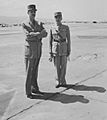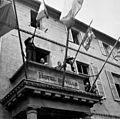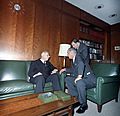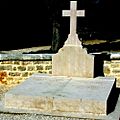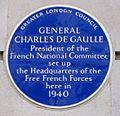Charles de Gaulle facts for kids
Quick facts for kids
Charles de Gaulle
|
|
|---|---|
 |
|
| 18th President of the French Republic | |
| In office January 8, 1959 – April 28, 1969 |
|
| Preceded by | René Coty |
| Succeeded by | Georges Pompidou |
| 149th Prime Minister of France | |
| In office June 1, 1958 – January 8, 1959 |
|
| Preceded by | Pierre Pflimlin |
| Succeeded by | Michel Debré |
| Personal details | |
| Born | November 22, 1890 Lille, France |
| Died | November 9, 1970 (aged 79) Colombey-les-deux-Églises, France |
| Political party | UDR |
| Spouse | Yvonne de Gaulle |
| Children | Philippe Élisabeth Anne |
Charles de Gaulle (born November 22, 1890, died November 9, 1970) was a very important French soldier and political leader. He was the president of France from 1959 to 1969. During World War II, he helped start and lead the French Resistance, a group that fought against Germany. Many people still see him as one of France's strongest leaders, even like Napoleon.
Contents
De Gaulle's Military Life
Charles de Gaulle fought in both World War I and World War II. He started his army career after finishing a famous French military school called Ecole Militaire de Saint-Cyr. In 1912, he joined the army's infantry, which are soldiers who fight on foot.
Fighting in World War I
During World War I, de Gaulle was captured at the Battle of Verdun. He was sent home after the war ended. Even after the war, Charles stayed in the military. He believed in new ways of fighting, like using armored machines such as tanks for troops.
Leading in World War II
When World War II began, de Gaulle created and led the Free French Forces. He did this because he strongly felt that France should not give up to Germany and its allies, known as the Axis forces.
As the French government surrendered to Germany, de Gaulle escaped to Britain. There, he set up his own French government, which he called Free France. He gathered support and French soldiers. These soldiers later helped to free France from Germany's control.
De Gaulle's Political Life
After World War II, de Gaulle stepped down as the leader of the temporary government in 1946. But in 1958, he came out of retirement. He was then elected President of France. He was reelected in 1965 and stayed president until he resigned in 1969.
France's Recovery and Growth
While de Gaulle was president, France recovered well from the war. The country also had great economic success, meaning its economy grew strong.
He also gave independence to Algeria and other African countries that had been under French rule.
Nuclear Power for France
Charles de Gaulle wanted France to have its own nuclear weapons. At that time, only the United States, Great Britain, and the Soviet Union had them. While he was President, France became one of the few major countries with nuclear weapons.
Later Life and Legacy
De Gaulle resigned from his presidency in April 1969. This happened after some of his ideas were not supported by many people in France. He went back home to his estate in Colombey-les-Deux-Églises. He passed away there just two weeks before his 80th birthday.
Famous Quotes by Charles de Gaulle
- "I have come to the conclusion that politics are too serious a matter to be left to the politicians."
- "I grew up to always respect authority and respect those in charge."
- "Diplomats are useful only in fair weather. As soon as it rains, they drown in every drop."
- "Don't ask me who's influenced me. A lion is made up of the lambs he's digested, and I've been reading all my life."
- "Nothing great will ever be achieved without great men, and men are great only if they are determined to be so."
Interesting Facts about Charles de Gaulle
- Charles de Gaulle was a general in the French army and later the President of France.
- He fought in both World War I and World War II.
- He was captured during World War I.
- Charles disagreed with French leaders who wanted to surrender to Germany. So, he left France and went to Great Britain. There, he formed the Free French Forces.
- Charles de Gaulle helped free France from Germany's control.
- He served as a temporary President after World War II until 1946.
- He was elected President in 1958.
- De Gaulle resigned from the presidency in April 1969 and died at home when he was almost 80 years old.
Images for kids
-
De Gaulle's birth house in Lille, now a national museum
-
A plaque in Dinant commemorating the place where Charles de Gaulle, then an infantry lieutenant, was wounded in 1914
-
De Gaulle speech plaquette on the Arc de Triomphe
-
De Gaulle at the start of the Brazzaville Conference, French Equatorial Africa, 1944
-
Charles de Gaulle (far right) with Andrew McNaughton, Władysław Sikorski, and Winston Churchill
-
At the Casablanca Conference (January 14, 1943), rival French leaders Henri Giraud (leftmost) and Charles de Gaulle (middle right) sit down after shaking hands in front of Franklin D. Roosevelt (middle left) and Winston Churchill (rightmost) — a public show of unity
-
Winston Churchill and General de Gaulle at Marrakesh, January 1944
-
General de Gaulle giving a speech in liberated Cherbourg from the town hall
-
General de Gaulle and his group walk down the Champs-Élysées after Paris was freed in August 1944
-
The 2nd Armored Division passes through the Arc de Triomphe. Signs read "Long live de Gaulle" and "De Gaulle to power".
-
De Gaulle presenting the Legion of Honour to American Army and Navy officers William D. Leahy, George C. Marshall, Ernest J. King, Henry H. Arnold and Brehon B. Somervell
-
1958 Time Man of the Year
-
The first meeting between David Ben-Gurion and de Gaulle at Élysée Palace, 1960
-
President John F. Kennedy and de Gaulle after their talks at Elysee Palace, 1961
-
De Gaulle with President Lyndon B. Johnson in Washington, D.C., 1963
-
De Gaulle and Konrad Adenauer in 1961
-
Iranian Empress Farah Pahlavi meeting with Charles de Gaulle in France, 1961
-
De Gaulle and Argentine president Arturo Illia in 1964
-
De Gaulle and Lyndon B. Johnson meeting at Konrad Adenauer's funeral in 1967, with President of West Germany Heinrich Lübke (center)
-
Newly elected U.S. president Richard Nixon visiting President De Gaulle one month before De Gaulle retired
-
Grave of Charles de Gaulle at Colombey-les-Deux-Églises
-
De Gaulle's home, La Boisserie, in Colombey-les-Deux-Églises
-
Blue plaque marking the headquarters of General de Gaulle at 4 Carlton Gardens in London during World War II
See also
 In Spanish: Charles de Gaulle para niños
In Spanish: Charles de Gaulle para niños



















